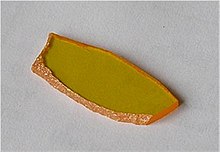
| |

| |
| Names | |
|---|---|
| Other names
Zinc selenide
Stilleite | |
| Identifiers | |
3D model (JSmol)
|
|
| ChemSpider | |
| ECHA InfoCard | 100.013.873 |
| EC Number |
|
PubChem CID
|
|
| UNII | |
CompTox Dashboard (EPA)
|
|
| |
| |
| Properties | |
| ZnSe | |
| Molar mass | 144.35 g/mol |
| Appearance | light yellow solid |
| Density | 5.27 g/cm3 |
| Melting point | 1,525 °C (2,777 °F) |
| negligible | |
| Band gap | 2.82 eV (10 K) |
Refractive index (nD)
|
2.67 (550 nm) 2.40 (10.6 μm) |
| Structure | |
| Zincblende (cubic) | |
a = 566.8 pm
| |
| Tetrahedral (Zn2+) Tetrahedral (Se2−) | |
| Thermochemistry | |
Std enthalpy of
formation (ΔfH⦵298) |
−177.6 kJ/mol |
| Hazards | |
| GHS labelling: | |
  
| |
| Danger | |
| H301, H331, H373, H410 | |
| P260, P261, P264, P270, P271, P273, P301+P310, P304+P340, P311, P314, P321, P330, P391, P403+P233, P405, P501 | |
| Related compounds | |
Other anions
|
Zinc oxide Zinc sulfide Zinc telluride |
Other cations
|
Cadmium selenide Mercury selenide |
Except where otherwise noted, data are given for materials in their standard state (at 25 °C [77 °F], 100 kPa).
| |
Zinc selenide is the inorganic compound with the formula ZnSe. It is a lemon-yellow solid although most samples have a duller color due to the effects of oxidation. It is an intrinsic semiconductor with a band gap of about 2.70 eV at 25 °C (77 °F). ZnSe occurs as the rare mineral stilleite, named after Hans Stille.
ZnSe is available in both hexagonal (wurtzite) and cubic (zincblende) polymorphs. In both cases, the Zn2+ and Se2− sites are tetrahedral. The difference in the structures related to close packing motifs, hexagonal vs cubic.
Cubic ZnSe is produced by treatment of an aqueous solution of zinc sulfate with hydrogen selenide:[1]
Heating the cubic form gives hexagonal ZnSe.
An alternative synthesis involves heating a mixture of zinc oxide, zinc sulfide, and selenium:
It is a wide-bandgap semiconductor of the II-VI semiconductor group (since zinc and selenium belong to the 12th and 16th groups of the periodic table, respectively). The material can be n-type doped with, for instance, halogen elements. P-type doping is more difficult, but can be achieved by introducing gallium.
ZnSe is insoluble in water, but dissolves in concentrated hydrochloric acid.
It can be deposited as a thin film by chemical vapour deposition techniques including MOVPE and vacuum evaporation.